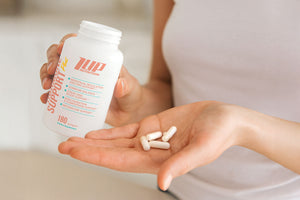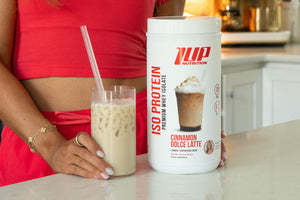What is Fat?
Fat is one of the three main macronutrients in our diet (the other two being protein and carbohydrate) that supplies our bodies with energy (calories).
Each gram of fat contains 9 calories per gram, making it the most calorically-dense macronutrient.
Beyond supplying the body with energy, dietary fat also serves a number of important roles in the body, including:
- Serving as structural building blocks of the body, particularly cell membranes
- Facilitate the absorption of fat-soluble vitamins (A, D, E, & K)
- Optimal growth and development
- Hormone production
- Promoting a healthy inflammatory response
Note: alcohol is considered the fourth macronutrient, but it shouldn’t compose a significant portion of daily energy intake...at least if you’re focused on health, wellness, and longevity.
Let’s now discuss the different types of fat you’ll encounter in daily life.
Types of Dietary Fat
Monounsaturated Fat
Monounsaturated fats are called such because their molecular structures are not saturated with hydrogen molecules. They have a single carbon bond in their structure.
Due to their structure not being saturated, monounsaturated fats are liquid at room temperature.
Notable examples of MUFAs include olive oil, canola oil, and peanut oil.
Monounsaturated fats are a cornerstone of the Mediterranean diet, and considered by most health authorities as one of the best types of fat to include in the diet.
These heart-healthy fats are known to support endothelial function as well as insulin levels and blood sugar control.[1,4]
Polyunsaturated Fat
Polyunsaturated fatty acids (PUFAs), like monounsaturated fats, are not saturated, but whereas MUFAs contain a single double (carbon) bond, PUFAs contain two or more.[2,3]
Also, much like monounsaturated fats, PUFAs are liquid at room temperature, and include such fats as soybean oil, sunflower oil, sunflower seeds, walnuts and flaxseeds. PUFAs are also found in fatty fish, such as tuna, salmon, mackerel, trout, and herring.
PUFAs have been found in research trials to beneficially impact blood cholesterol levels resulting in a reduced risk of cardiovascular disease (CVD).
Additional studies also suggest that PUFAs support cell development and maintenance and also aid the absorption of vitamin E -- a vitally important antioxidant in the body.[5]
Essential Fatty Acids
The family of PUFAs also include the omega-6 and omega-3 essential fatty acids (EFAs) and have known beneficial roles in human health. Essential fatty acids are termed as such due to the fact that the body cannot synthesize them, and they must be obtained through the diet.
There are three types of omega-3 fatty acids:
- Alpha linolenic acid -- ALA
- Eicosapentaenoic acid -- EPA
- Docosahexaenoic acid -- DHA
ALA is the most common essential fatty acid, typically found most abundantly in plant foods. Upon ingestion, the body converts ALA to the bioavailable (“useful”) forms -- EPA and DHA.
However, this conversion process is horrifically inefficient, with only somewhere between 2-10% of ALA being converted to EPA and DHA.[6]
Since this conversion process is so inefficient, most people get their omega-3 fatty acids from animal sources, which are higher in EPA and DHA -- the biologically active forms of omega-3s.
The richest sources of EPA and DHA are oily fish, including anchovy, salmon, tuna and mackerel.
For individuals who do not enjoy the taste or texture of fish, supplementing with omega-3 fatty acids is another appealing (not to mention cost effective option).
1UP Omega-3 supplies two grams of premium-quality, high-strength omega-rich fish oil concentrate, including 720mg EPA and 480mg DHA.
Benefits attributed to omega-3 fatty acid intake include[7,8,9]:
- A reduction in oxidative stress
- Decreased inflammation
- Better muscle recovery
- Improved cognitive function
- Improved eye health
- Improved triglyceride and cholesterol panels
- Reduce blood pressure in hypertensive individuals
As we mentioned above, the other family of essential fatty acids are omega-6 fatty acids.
There are four types of omega-6 fatty acids:
- Linoleic acid -- LA
- Arachidonic Acid -- ARA
- Gamma linoleic -- GLA
- Conjugated linoleic acid -- CLA
Omega-6 fatty acids support healthy skin, hair, and nail growth. They also help maintain bone health as well as the reproductive system.
Saturated Fat
Saturated fats are saturated with hydrogen molecules, meaning there are no carbon bonds as there are with MUFAs and PUFAs.
As a result, saturated fats are solid at room temperature.
This type of fat occurs in animal-based foods, including:
- Red meat (beef, bison, elk, etc.)
- Poultry (chicken, turkey, duck, etc.)
- Dairy (yogurt, cheese, milk, cottage cheese, etc.)
- Eggs
There has been a great debate over the past several decades over the safety of saturated fat intake. At one time, saturated fat was viewed as the predominant contributing factor to cardiovascular disease.
Various studies have also found that replacing saturated fats with MUFAs and PUFAs may help reduce the risk of heart disease on par with that of cholesterol-lowering drugs, like statins.
However, the narrative around saturated fat has begun to shift in recent years, as better quality studies have been published, mostly exonerating saturated fat as the lone culprit in CVD.
Still, the recommendation from most health organizations is to limit saturated fat to <10% of daily calories.[2]
Trans-Fat
Trans fats are man-made fats created by hydrogenating vegetable oils, and they are considered the only “bad” dietary fat that should be avoided as much as possible.
Essentially, trans fats are created by adding hydrogen to liquid vegetable oils to make them more solid.
This is done to increase the shelf life of packaged, processed foods, such as:
- Vegetable shortening
- Margarines
- Crackers
- Cookies
- Boxed cake mixes
- Frozen pizzas
The FDA, as well as many other international regulatory agencies, have taken steps to forbid the use of trans-fat in packaged goods due to their research indicating their consumption will raise bad (LDL) cholesterol levels and lower good (HDL) cholesterol levels, thereby increasing the risk of developing heart disease.
How Much Dietary Fat Should I Eat?
Dietary guidelines issued by the World Health Organization and the Dietary Reference Intakes recommend a total fat intake between 20-35% of total calories.[2]
This provides sufficient fat intake for total energy intake, essential fatty acids, hormone production, and the absorption of fat-soluble vitamins (A, D, E, & K).
Interestingly, the average fat intake in the United States has decreased from 36.6 to 33.6% of total daily calories as has the amount of saturated fat intake.
Regarding the intake of omega-3 fatty acids, the World Health Organization recommends a daily intake of 0.250 g/day of EPA plus DHA.
To help individuals hit their recommended intakes for essential fatty acids, we developed 1UP Omega-3, which supplies two grams of premium-quality, high-strength omega-rich fish oil concentrate, including 720mg EPA and 480mg DHA.
References
- Sacks FM, Lichtenstein AH, Wu JHY, et al. Dietary Fats and Cardiovascular Disease: A Presidential Advisory From the American Heart Association [published correction appears in Circulation. 2017 Sep 5;136(10 ):e195]. Circulation. 2017;136(3):e1-e23. doi:10.1161/CIR.0000000000000510
- Liu AG, Ford NA, Hu FB, Zelman KM, Mozaffarian D, Kris-Etherton PM. A healthy approach to dietary fats: understanding the science and taking action to reduce consumer confusion. Nutr J. 2017;16(1):53. Published 2017 Aug 30. doi:10.1186/s12937-017-0271-4
- Nettleton JA, Brouwer IA, Mensink RP, Diekman C, Hornstra G. Fats in Foods: Current Evidence for Dietary Advice. Ann Nutr Metab. 2018;72(3):248-254. doi:10.1159/000488006
- Hayes J, Benson G. What the Latest Evidence Tells Us About Fat and Cardiovascular Health. Diabetes Spectr. 2016;29(3):171-175. doi:10.2337/diaspect.29.3.171
- Raederstorff D, Wyss A, Calder PC, Weber P, Eggersdorfer M. Vitamin E function and requirements in relation to PUFA. Br J Nutr. 2015;114(8):1113-1122. doi:10.1017/S000711451500272X
- Gerster H. Can adults adequately convert alpha-linolenic acid (18:3n-3) to eicosapentaenoic acid (20:5n-3) and docosahexaenoic acid (22:6n-3)? Int J Vitam Nutr Res. 1998;68(3):159-73. PMID: 9637947.
- Cazzola R, Russo-Volpe S, Miles EA, Rees D, Banerjee T, Roynette CE, Wells SJ, Goua M, Wahle KW, Calder PC, Cestaro B. Age- and dose-dependent effects of an eicosapentaenoic acid-rich oil on cardiovascular risk factors in healthy male subjects. Atherosclerosis. 2007 Jul;193(1):159-67. doi: 10.1016/j.atherosclerosis.2006.06.008. Epub 2006 Aug 1. PMID: 16879829.






